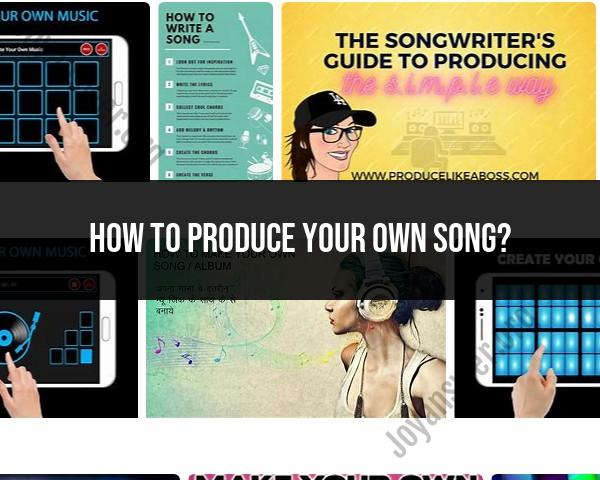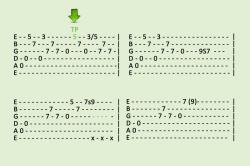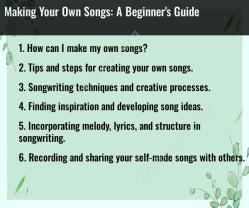How to produce your own song?
Producing your own song involves turning your musical ideas into a fully realized track. Whether you're a singer-songwriter, a composer, or a producer, here's a step-by-step guide on how to produce your own song:
1. Pre-Production:
a. Songwriting and Composition:- Start with a well-written song. This includes lyrics, melody, and chord progressions. Make sure your song has a clear structure with verses, chorus, and bridge if applicable.
b. Instrumentation and Arrangement:- Decide on the instruments and sounds you want to use in your song. This can include guitars, keyboards, drums, and virtual instruments. Plan the arrangement, considering when each instrument or element will come in and how they interact.
c. Tempo and Key:- Determine the tempo and key of your song. This will help with recording and selecting the right instruments.
2. Recording:
a. Set Up Your Recording Space:- Choose a quiet and acoustically controlled room for recording. Invest in quality microphones, audio interfaces, headphones, and studio monitors.
b. Multitrack Recording:- Record each instrument or vocal separately. This allows you to have control over each track during mixing.
c. Capture the Best Performance:- When recording vocals or instruments, aim for the best possible performance. Multiple takes can be edited and comped together later.
3. Editing:
a. Editing the Tracks:- Edit and clean up each track. This can involve removing background noise, aligning tracks to the grid, and correcting minor mistakes.
b. Comp Takes:- If you recorded multiple takes, select the best parts from each take to create a composite (comp) track.
4. Mixing:
a. Balance the Tracks:- Adjust the volume and panning of each track to create a balanced mix. Ensure that no instrument or vocal dominates the mix.
b. Equalization (EQ):- Use EQ to shape the tonal balance of each track. Boost or cut frequencies to make instruments sit well together.
c. Effects and Processing:- Add reverb, delay, compression, and other effects as needed to enhance the sound.
d. Automation:- Automate volume, panning, and effects parameters to add movement and dynamics to the mix.
5. Mastering:
a. Mastering Prep:- If you're producing a single song, you can master it yourself using mastering software. For an album or professional release, consider sending your mix to a mastering engineer.
b. Mastering Process:- Mastering involves final adjustments to overall EQ, compression, limiting, and formatting for the intended distribution platform (e.g., CD, streaming services).
6. Exporting:
- Export the final mix as a high-quality audio file (e.g., WAV or AIFF) at the appropriate sample rate and bit depth.
7. Distribution:
- Decide how you want to distribute your song. You can release it on streaming platforms, create physical copies, or use your song for personal or promotional purposes.
8. Promotion:
- Promote your song through social media, music websites, live performances, and other channels to reach your target audience.
9. Continue Learning:
- Producing music is a skill that can always be improved. Keep learning about recording and production techniques, and stay updated on industry trends.
Remember that producing your own song can be a complex process, and you might encounter challenges along the way. Don't hesitate to seek advice from experienced musicians or producers and invest time in learning and improving your production skills. Each song you create is an opportunity to grow and refine your craft.
The process of producing your own song from start to finish
The process of producing your own song from start to finish can be broken down into the following steps:
- Songwriting: This is the process of writing the melody, harmony, and lyrics of your song.
- Recording: This is the process of capturing your song's audio to a digital audio workstation (DAW).
- Editing: Once you have recorded your song, you may need to edit it to remove any mistakes or to improve the performance.
- Mixing: This is the process of balancing the levels of all the different instruments and vocals in your song.
- Mastering: This is the final step in the production process, where your song is polished and prepared for release.
Equipment and software tools for music production at home
Here is a basic list of equipment and software tools that you will need to produce your own music at home:
- Computer: A computer is essential for running a DAW and other music production software.
- DAW: A DAW is a software program that allows you to record, edit, mix, and master your music.
- Audio interface: An audio interface is a device that connects your microphone and other instruments to your computer.
- Microphone: A microphone is used to record sound.
- Monitors: Monitors are speakers that are specifically designed for music production.
In addition to this basic equipment, you may also want to consider purchasing the following:
- MIDI controller: A MIDI controller is a device that allows you to control your DAW and other music production software using physical controls.
- Synthesizer: A synthesizer is a device that generates electronic sounds.
- Samplers: A sampler is a device that allows you to record and playback audio samples.
- Effects pedals: Effects pedals can be used to add effects to your music, such as reverb, delay, and distortion.
Techniques for recording, mixing, and mastering your songs
There are many different techniques for recording, mixing, and mastering your songs. Here are a few basic tips:
- Recording: When recording your song, try to get the best possible sound quality. This means using a good microphone and recording in a quiet environment.
- Mixing: When mixing your song, try to balance the levels of all the different instruments and vocals. You should also use panning and EQ to create a stereo soundscape.
- Mastering: When mastering your song, you should normalize the volume and add any final touches, such as compression and limiting.
Collaboration and seeking professional assistance in music production
Collaboration and seeking professional assistance can be a great way to improve your music production skills and to create better songs. Here are a few tips:
- Collaborate with other musicians: Collaborating with other musicians can help you to come up with new ideas and to learn from each other.
- Seek feedback from other producers: Getting feedback from other producers can help you to identify areas where your music can be improved.
- Hire a professional engineer: If you are serious about music production, you may want to consider hiring a professional engineer to mix and master your songs.
Showcasing and distributing your self-produced music to a wider audience
Once you have produced your song, you will want to share it with the world. Here are a few ways to showcase and distribute your self-produced music to a wider audience:
- Upload your music to streaming platforms: Streaming platforms like Spotify, Apple Music, and Amazon Music make it easy for people to listen to your music.
- Share your music on social media: Use social media platforms like Facebook, Instagram, and Twitter to share your music with your followers.
- Play live shows: Playing live shows is a great way to connect with fans and to promote your music.
- Submit your music to blogs and radio stations: Submitting your music to blogs and radio stations can help you to reach a wider audience.
Producing your own music can be a rewarding experience. By following the tips above, you can create your own songs and share them with the world.












